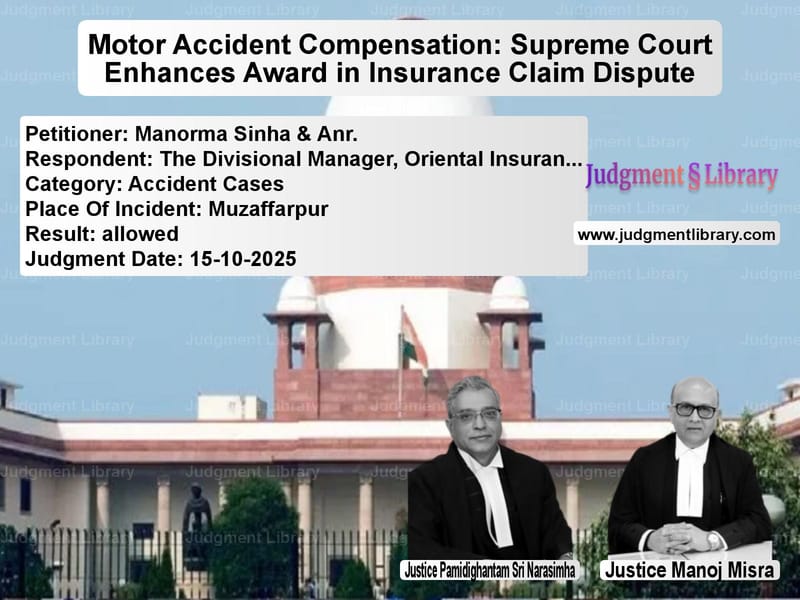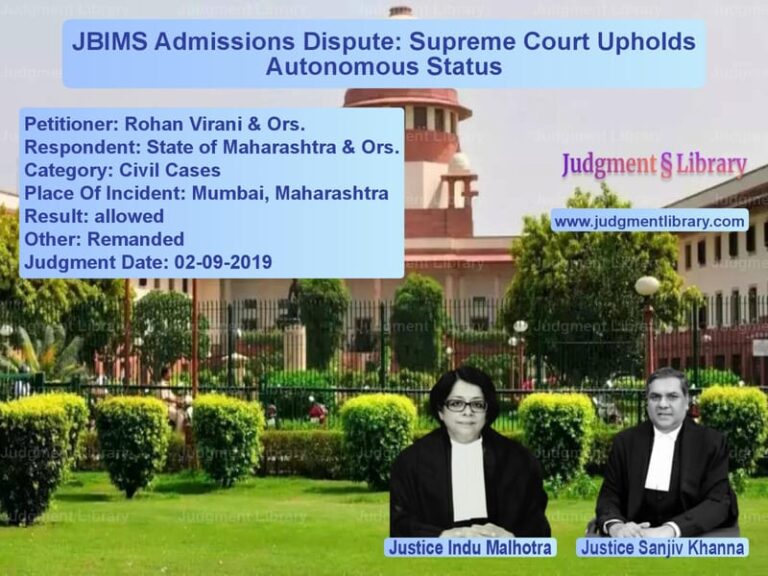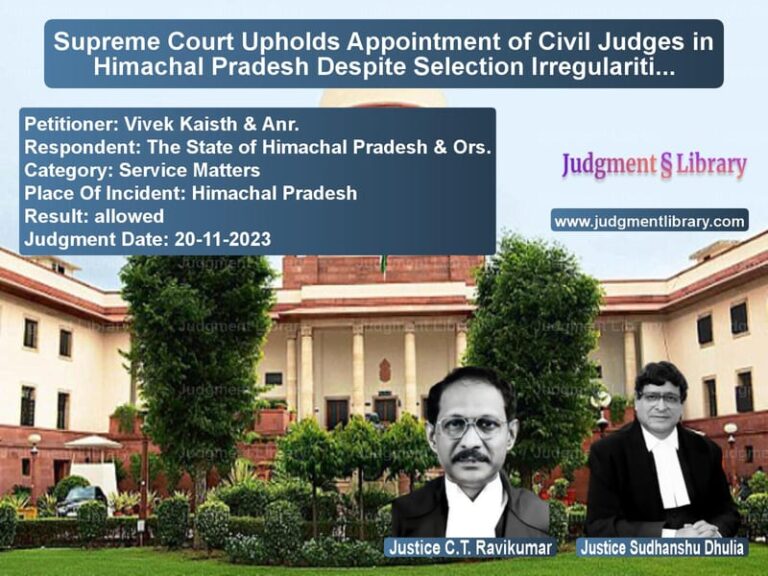Motor Accident Compensation: Supreme Court Enhances Award in Insurance Claim Dispute
In a significant judgment delivered on October 15, 2025, the Supreme Court of India addressed a crucial motor accident compensation case that revolved around the proper calculation methodology for determining compensation amounts. The case involved the family of a 27-year-old engineer who died in a road accident, and the dispute centered on how various components of salary, future prospects, and income tax deductions should be factored into compensation calculations.
The Tragic Accident and Initial Proceedings
The case began with a tragic road accident that claimed the life of a young engineer employed with Power Grid Corporation of India. The deceased was only 27 years old at the time of his untimely death, leaving behind grieving family members who sought compensation for their immense loss. The initial claim was filed before the Motor Accident Claims Tribunal in Muzaffarpur, which after careful consideration, awarded compensation of Rs. 88,20,454 to the family.
The Tribunal’s calculation considered the engineer’s complete salary package, including basic pay of Rs. 26,420, dearness allowance of Rs. 11,360, local allowance of Rs. 2,642, and other allowances totaling Rs. 12,945.80, bringing the total monthly salary to Rs. 53,367. Using established legal principles, the Tribunal applied a multiplier of 18, deducted 50% for personal expenses, added 50% for future prospects, and included conventional heads like loss of estate, love and affection, and funeral expenses.
The High Court’s Drastic Reduction
The insurance company appealed to the Patna High Court, challenging the compensation amount. The High Court substantially reduced the compensation from Rs. 88,20,454 to Rs. 38,15,499 – a reduction of more than Rs. 50 lakhs. This drastic cut was primarily due to three key changes in the calculation methodology.
First, the High Court excluded all allowances from the salary calculation, considering only the basic pay and dearness allowance. Second, it reduced the future prospects addition from 50% to 40%. Third, and most significantly, it made a flat 30% deduction for income tax without considering the actual tax slabs applicable in the relevant year. The High Court also changed the multiplier from 18 to 17 and reduced the amounts under conventional heads.
The Supreme Court Appeal
The aggrieved family approached the Supreme Court, arguing that the High Court’s approach was erroneous and contrary to established legal principles. The appellants’ counsel made several key submissions before the Court. They argued that “the High Court has erred in not including the allowances payable for computing the compensation” and “has also erred in reducing the income by a flat rate of 30% deductible towards income tax even though it might not be even leviable.”
The counsel emphasized that “if any deduction towards income tax is to be made it cannot be at a rate different from the rate at which the tax is payable on the annualized income based on the last pay slip.” They provided detailed information about the income tax slabs prevailing in 2011, when the accident occurred, showing that a flat 30% deduction was excessive and incorrect.
The insurance company’s counsel defended the High Court’s approach, arguing that “though the tax payable may vary but the allowances must be excluded in computation of salary” based on previous court decisions. They also maintained that “while computing compensation deduction towards income tax is to be made” as per established legal precedent.
The Supreme Court’s Detailed Analysis
The Supreme Court bench comprising Justices Pamidighantam Sri Narasimha and Manoj Misra conducted a thorough examination of the legal principles governing compensation calculation in motor accident cases. The Court addressed each contentious issue systematically, drawing upon established precedents and legal principles.
On the crucial question of whether allowances should be included in salary calculation, the Court referred to several important precedents. Quoting from National Insurance Co. Ltd. v. Indira Srivastava & Ors., the Court noted that “the term income has different connotations for different purposes. A court of law, having regard to the change in societal conditions consider the question not only having regard to pay packet the employee carries home at the end of the month but also other perks which are beneficial to the members of the entire family.”
The Court further relied on Vijay Kumar Rastogi v. Uttar Pradesh State Roadways Transport Corporation, where a three-judge bench had observed that “the income should include those benefits, either in terms of money or otherwise, which are taken into consideration for the purpose of payment of income tax or professional tax, although some elements thereof may not be taxable due to exemption conferred thereupon under the statute.”
Following these principles, the Supreme Court concluded that “the High Court erred in excluding the allowances from the computation to arrive at the multiplicand. Hence, the total monthly income was rightly computed by the Tribunal at Rs.53,367.”
Income Tax Deduction Principles
Regarding the contentious issue of income tax deduction, the Supreme Court acknowledged that deduction towards income tax is permissible as established in Ranjana Prakash & others v. Divisional Manager & another. However, the Court emphasized that “deduction towards income tax should be at such rate which the annual income may be subjected to in the relevant year.”
The Court rejected the High Court’s approach of applying a flat 30% deduction, noting that “It is not demonstrated that the allowances received were exempt from income tax. Even the nature of allowances has not been disclosed to enable us to determine whether they are exempt from tax.” Therefore, the Court included all allowances in the annual income and computed the actual tax liability based on the slabs applicable in 2011.
The Court calculated the annual income as Rs. 6,40,400 and determined that the actual tax payable would be Rs. 62,080 (Nil tax up to Rs. 1.60 lakhs; Rs. 34,000 @ 10% up to Rs. 5.00 lakhs; and Rs. 28,080 @ 20% up to Rs. 6,40,400). This resulted in a net annual income of Rs. 5,78,324 after tax deduction, significantly different from the High Court’s calculation.
Future Prospects and Other Components
On the issue of future prospects, the Supreme Court restored the Tribunal’s approach of adding 50% rather than the High Court’s 40%. The Court noted that “the deceased was an Engineer employed with Power Grid Corporation of India, which is a public sector undertaking. There is no material to indicate that his job was not permanent in nature or that he was on a contract for a limited period.”
The Court referred to the landmark judgment in Pranay Sethi, which established that for persons below 40 years of age in permanent employment, future prospects should be added at 50%. Therefore, the Court held that “the High Court was not justified in adding future prospects at the rate of 40% in place of 50% as awarded by the Tribunal.”
The Court also corrected the multiplier, agreeing with the High Court’s use of 17 (appropriate for age 27) rather than the Tribunal’s 18, and standardized the conventional heads as per established principles.
The Final Compensation Calculation
After considering all factors, the Supreme Court arrived at a balanced compensation amount. The Court computed the net annual income after tax as Rs. 5,78,324. After deducting 50% for personal expenses, the amount came to Rs. 2,89,162. Adding 50% for future prospects (Rs. 1,44,581) resulted in a net annual income of Rs. 4,33,743 for dependency calculation.
Applying the multiplier of 17, the loss of dependency was calculated as Rs. 73,73,631. Adding conventional heads – Rs. 15,000 for loss of estate, Rs. 40,000 for loss of filial consortium, and Rs. 15,000 for funeral expenses – brought the total compensation to Rs. 74,43,631.
The Supreme Court thus allowed the appeal and modified the High Court’s order, directing the insurance company to pay Rs. 74,43,631 to the appellants with interest at 6% per annum from the date of the claim petition till actual payment.
Broader Implications
This judgment has significant implications for motor accident compensation cases across India. It reaffirms the principle that compensation calculations must be based on the complete salary package, including all allowances, rather than just basic pay. The judgment also establishes that income tax deductions must be calculated based on actual tax slabs applicable in the relevant year, not arbitrary percentages.
Most importantly, the Supreme Court’s approach demonstrates a balanced consideration of both the financial loss suffered by the family and the need for realistic, principle-based calculations. By enhancing the compensation from the High Court’s Rs. 38,15,499 to Rs. 74,43,631, the Court ensured that the family received fair compensation for their tragic loss while maintaining legal consistency in compensation calculation methodology.
The judgment serves as an important precedent for future cases, providing clear guidance on how to approach complex calculations involving salary components, future prospects, and tax implications in motor accident compensation claims.
Petitioner Name: Manorma Sinha & Anr..Respondent Name: The Divisional Manager, Oriental Insurance Company Limited & Anr..Judgment By: Justice Pamidighantam Sri Narasimha, Justice Manoj Misra.Place Of Incident: Muzaffarpur.Judgment Date: 15-10-2025.Result: allowed.
Don’t miss out on the full details! Download the complete judgment in PDF format below and gain valuable insights instantly!
Download Judgment: manorma-sinha-&-anr.-vs-the-divisional-manag-supreme-court-of-india-judgment-dated-15-10-2025.pdf
Directly Download Judgment: Directly download this Judgment
See all petitions in Road Accident Cases
See all petitions in Compensation Disputes
See all petitions in Motor Vehicle Act
See all petitions in Insurance Settlements
See all petitions in Third-Party Insurance
See all petitions in Judgment by P.S. Narasimha
See all petitions in Judgment by Manoj Misra
See all petitions in allowed
See all petitions in supreme court of India judgments October 2025
See all petitions in 2025 judgments
See all posts in Accident Cases Category
See all allowed petitions in Accident Cases Category
See all Dismissed petitions in Accident Cases Category
See all partially allowed petitions in Accident Cases Category







